How to Create a Customer Service Strategy for 2024
A solid customer service strategy is grounded in simple, honest interactions. It simply needs to show your customers, acknowledge their frustrations and fix what went wrong.

A strong customer service strategy is the cornerstone of any successful business. But kicking off a customer service strategy can be daunting.
While we understand, ensuring every customer feels heard and valued. 65% of customers switch brands due to a single bad experience and the threat of customer churn is palpable.
Creating an effective customer support strategy framework requires investing in every contact. From developing easy onboarding processes to crafting helpful content, you need to ensure that all points are optimized for delivering exceptional experiences.
Let’s get into how we can craft a strategy that sticks and makes every customer feel like they matter – because they do.
A customer support strategy is defined as the blueprint for how a business interacts and provides support to its customers at every touchpoint of the customer journey. It defines how employees handle customer issues over email, phone calls, web chats or social media messages.
A customer service strategy framework indicates a set of practices and policies that companies use to manage support inquiries like product returns or refunds. An effective customer service strategy plan should include all elements of the customer’s journey from pre-purchase research to post-purchase response and satisfaction.
The main objectives of a customer service strategy are to:
An effective customer service strategy focuses on providing an outstanding experience that meets the client’s expectations and delighting customers.
Key benefits of having an effective customer service strategy in place:
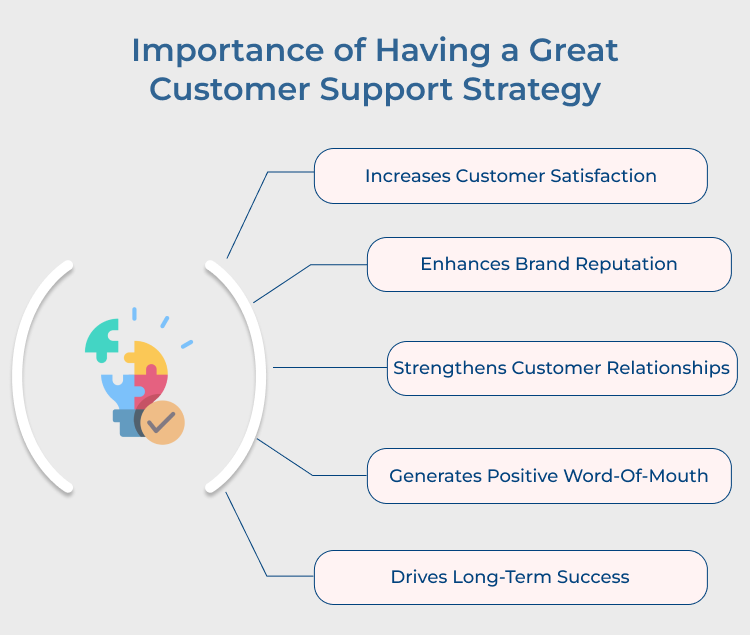
Keeping clients engaged and satisfied is crucial for businesses to develop effective customer service strategies that address the needs of their specific customer base.
Let us discuss the winning customer service strategies to help your business succeed:
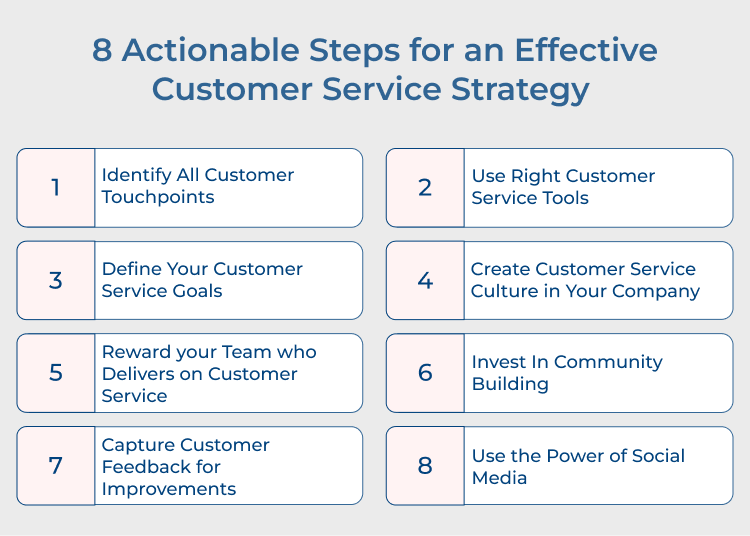
No matter how great a business’s customer service strategy might be, it’s important that everyone understands what success looks like so they can strive towards reaching those goals.
Having SMART (Specific, Measurable, Achievable, Relevant, Time-bound) objectives will help you maintain focus on what needs doing to reach those targets within specified timescales which translates into tangible results.
Make sure you regularly measure success by collecting feedback from both employees and customers. Track data at regular intervals to ensure program continuous improvements is helping to increase productivity or not.

Best practices:
Creating a successful customer service strategy framework requires mapping out all of your touch points – including both digital (e.g., email, website etc.) and analog (e.g., call centers) – with existing customers as well as how prospective customers are interacting.
Understanding these points of contact is essential in creating an effective customer service plan that addresses not only what is happening currently but also potential future needs or changes that may arise.
When you have a clear idea of the touchpoints, you can then move on to defining what the ideal experience should look like for each one and determine the resources needed to achieve it.
Pro tips:
Leveraging the right customer service tools is important to encourage customers to have greater interaction with their brand. It helps you to build your brand credibility and deliver a great customer experience.
Businesses should invest in the right tools for their particular industry or area of expertise such as:
Empowering your support team with the tools can be a good customer support trick bringing in benefits like:
A company-wide emphasis on customer service is essential for any successful business. It must begin with an expectation from the top that all stakeholders within the company put their customers at the forefront of their decision-making.
Training programs, regular meetings and other techniques should be used to ensure that everyone understands the importance of meeting customer expectations. A rewards system can be implemented to encourage staff to go beyond what is expected of them when providing exceptional customer service.
Pro tips
The efforts of the support staff that directly impact customer satisfaction must be properly rewarded because it shows employees that their efforts are valued and appreciated.
For instance, you can offer bonuses or incentives to team members who consistently deliver impacts across different metrics such as response rate or duration (i.e. how quickly they reply to customers).

Managers should also take note of exceptional cases where staff members exceed expectations. Giving recognition publicly or privately will show them the value of their contributions.
Best practices:
Investing in building communities around your service/product pays off for both your company and its customers.
Social media channels like Twitter and Instagram are key channels through which online conversations happen – so leveraging these networks allows businesses to build relationships with existing customers as well as reach out to potential prospects.
Discord groups or private chats in Facebook groups help create a sense of belonging among users combining fun activities with useful knowledge. Deepening user engagement would provide more honest feedback about products/services allowing companies to resolve issues more proactively.
Pro tips:
The ability to capture customer feedback can make all the difference when it comes to providing superior customer service.
Gathering real-time feedback during and after interactions ensures that businesses can quickly address pain points. It helps to create better experiences and enhance customer loyalty.

Businesses should invest in capturing customer feedback via different ways like surveys, focus groups, automated text messages, or online polls and use the insight gained to further refine their service strategies.
Best practices:
Social media platforms provide businesses with the unparalleled opportunity to interact with customers both independently and collaboratively.
Using social networks like Twitter, Instagram, and Facebook helps businesses to effectively exceed customer expectations, build strong client relationships, and deliver faster resolutions that will encourage greater advocacy.
Best practices:
A well-outlined service strategy is essential for any successful business. It is the key to retaining customers, building a positive reputation and increasing sales.
Here are a few qualities that all top-notch customer service representatives possess:
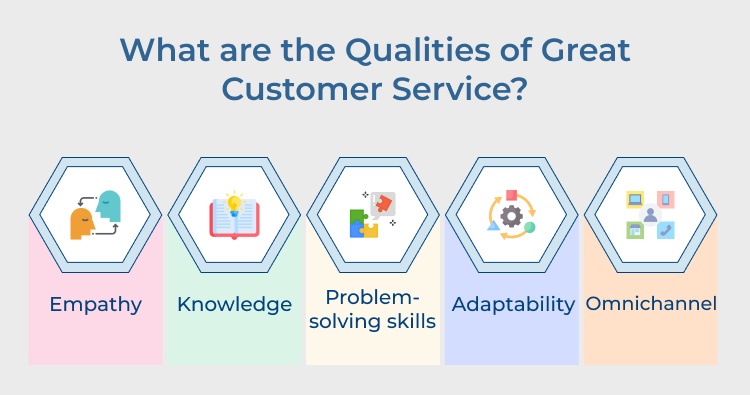
A great customer support strategy prioritizes empathy, training representatives to genuinely understand and relate to customer’s feelings and perspectives. This involves active listening, acknowledging emotions, and responding with compassion.
Empathetic support creates a connection with customers, making them feel valued and understood. It transforms potentially negative experiences into positive ones, fostering customer loyalty and enhancing the overall brand image.
A strong customer support strategy emphasizes comprehensive knowledge of products, services, and company policies. It involves ongoing training programs to keep staff updated on new developments and common issues.
Knowledgeable reps can provide accurate information, offer effective solutions, and answer complex queries confidently. It builds customer trust, reduces resolution times, and minimizes the need for escalations, which results in higher satisfaction ratio.
Excellent problem-solving skills are crucial in a great customer support strategy. It involves training staff to think critically, analyze situations quickly, and develop creative solutions. A problem-solving approach moves beyond script-following to address customer issues effectively.
The skills also include the ability to identify root causes, anticipate potential complications, and provide long-term solutions. Strong problem-solving skills lead to faster resolutions and valuable insights for product or service improvements.
Adaptability is key in a superior customer support strategy. It involves the flexibility to adjust to changing customer needs, new technologies, and evolving market conditions. An adaptable strategy can quickly pivot during crises and embrace new support channels.
Strong adaptability has the ability to personalize interactions based on individual customer preferences and situations. It ensures the support strategy remains effective and relevant in a dynamic business environment.
An effective customer support strategy embraces an omnichannel approach, providing seamless support across multiple platforms. It ensures customers can reach out through their preferred method and receive consistent service quality.
An omnichannel strategy maintains context across all channels, allowing customers to switch between platforms without repeating information. It enhances accessibility, improves customer experience, and caters to diverse customer preferences.
Customer support is a crucial aspect of any business that greatly impacts satisfaction and loyalty. Implementing best practices in your customer support strategy ensures that your customers receive the help and assistance they need promptly.
Here are some best practices to improve your customer support strategy:
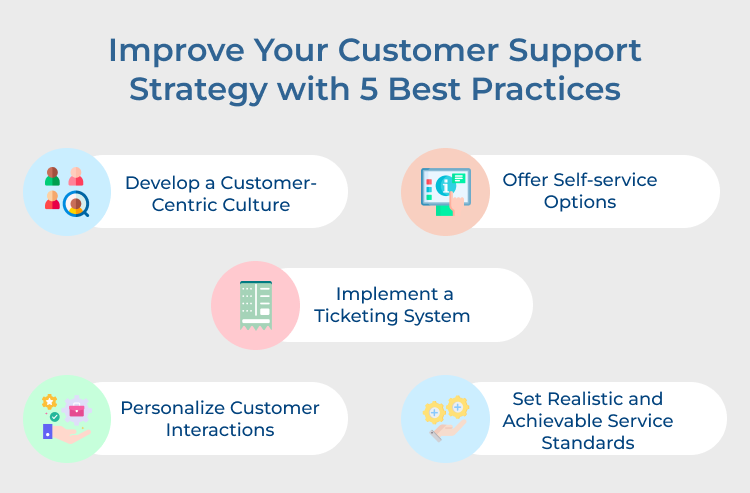
Customer service starts from within your company. The leaders should focus on cultivating a culture that values and prioritizes the satisfaction of customers. It can be achieved by providing comprehensive employee training, emphasizing the importance of delivering exceptional service, and rewarding outstanding customer service efforts.
Empowering customers to find solutions to their problems independently can improve customer satisfaction and reduce the workload on your support team. Implement self-service options, such as FAQ pages, knowledge bases, and video tutorials, to provide customers with the resources they need to resolve common issues.
A ticketing system helps streamline the customer support process by organizing customer inquiries and tracking their progress. The system allows your team to prioritize and assign tasks efficiently, ensuring that no customer inquiry falls through the cracks.
Customers appreciate personalized interactions that show you value their business. Use customer data to personalize responses and provide tailored solutions to their inquiries. Remembering details about previous interactions can also help build rapport and strengthen customer relationships.
Establishing clear service standards helps to ensure consistency and quality in your customer interactions. Define measurable service metrics and set realistic goals for response times. Regularly monitor your performance against these standards and make necessary adjustments to continuously improve.
A successful customer support strategy example can lead to increased customer satisfaction, loyalty, and more business.
Here are some real-life examples of companies that have implemented successful customer support strategies:
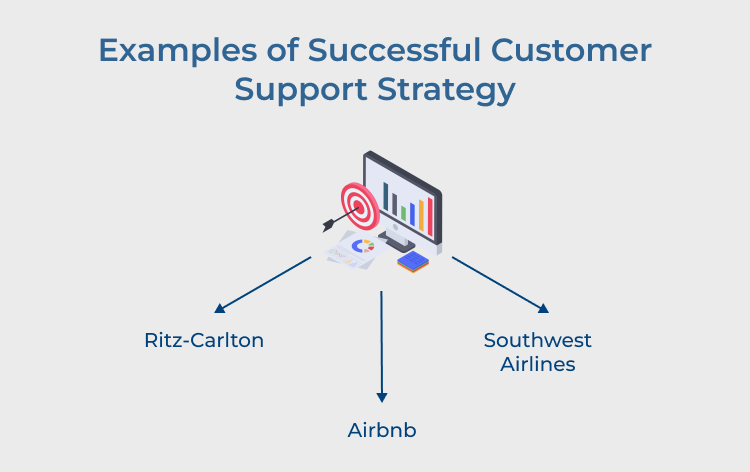
The Ritz-Carlton is a luxury hotel chain that is renowned for its exceptional customer service. They have a motto of “Ladies & Gentlemen serving Ladies and Gentlemen,” which emphasizes the importance of treating customers with respect and dignity.
The Ritz-Carlton empowers its employees to go the extra mile to deliver personalized service. The dedication to customer care has earned The Ritz-Carlton numerous awards for customer satisfaction and loyalty.
Airbnb, a platform for booking accommodations, has built a reputation for its responsive and helpful customer support team. The company provides multiple avenues for customers to contact support, including a 24/7 helpline and email support.
Airbnb also offers a resolution center where customers can quickly and easily resolve any issues that may arise during their stay. The proactive approach to customer support has helped Airbnb build trust with its users and maintain a high level of customer satisfaction.
Southwest Airlines is known for its friendly and attentive customer service. They have a customer-first approach that focuses on making customers feel valued and appreciated.
Southwest Airlines goes above & beyond to address customer concerns and provide solutions that exceed expectations. Their commitment to customer satisfaction has earned them a loyal customer base and high customer loyalty ratings.
Having a great customer service strategy is essential to delivering a great customer experience. Without such a plan, companies may struggle to retain loyal customers who need help and guidance while they are making use of their services or products. Not only will it lead to dissatisfaction among customers, but it could hurt the company’s reputation and reduce its overall profitability.
A lack of adequate customer service could result in more expensive marketing efforts on the part of the company as it tries to draw in new business to replace the customers it has lost due to bad service. Therefore, businesses should invest in developing an efficient customer service strategy that meets their customers’ needs, thereby ensuring customer loyalty and profit growth.
How can I create a more successful customer service strategy?
To create a more successful customer service strategy, businesses can start by understanding their target customers and their specific needs. They should also invest in training their employees to provide top-notch customer service, as well as collecting feedback from customers to continuously improve their strategies.
How can you develop a customer service strategy that meets the needs of your customers?
Developing a customer service strategy that meets the needs of customers involves listening to feedback, responding to inquiries promptly, and personalizing interactions with customers. Businesses should also focus on creating a positive customer experience at every touchpoint, from initial contact to post-purchase support.
What are some common mistakes to avoid when creating a customer service strategy?
Some common mistakes to avoid when creating a customer service strategy include neglecting to train employees properly, failing to listen to customer feedback, and not prioritizing customer satisfaction. It’s important for businesses to continuously evaluate and adjust their strategies based on customer feedback.
What are the 7 steps to developing a customer service strategy?
The 7 steps to developing a customer service strategy can include conducting research to
By following these steps, businesses can create a strong and effective customer service strategy that aligns with their overall goals.
What role does technology play in a customer service strategy?
Technology plays a crucial role in modern customer service strategies. It enables efficient communication through multiple channels, automates routine tasks, and provides valuable data insights. Tools like CRM systems, AI chatbots, and self-service portals enhance customer experience and operational efficiency. Technology also facilitates personalization, faster response times, and more accurate problem-solving, ultimately leading to improved customer satisfaction and loyalty.
How does a customer service strategy impact customer satisfaction and loyalty?
A well-executed customer service strategy significantly impacts satisfaction and loyalty by ensuring consistent, high-quality interactions across all touchpoints. It helps in quickly resolving issues, personalizing experiences, and exceeding customer expectations. This leads to increased trust, positive word-of-mouth, and repeat business. A strong strategy also allows for proactive engagement, making customers feel valued and understood, which further enhances their loyalty to the brand.